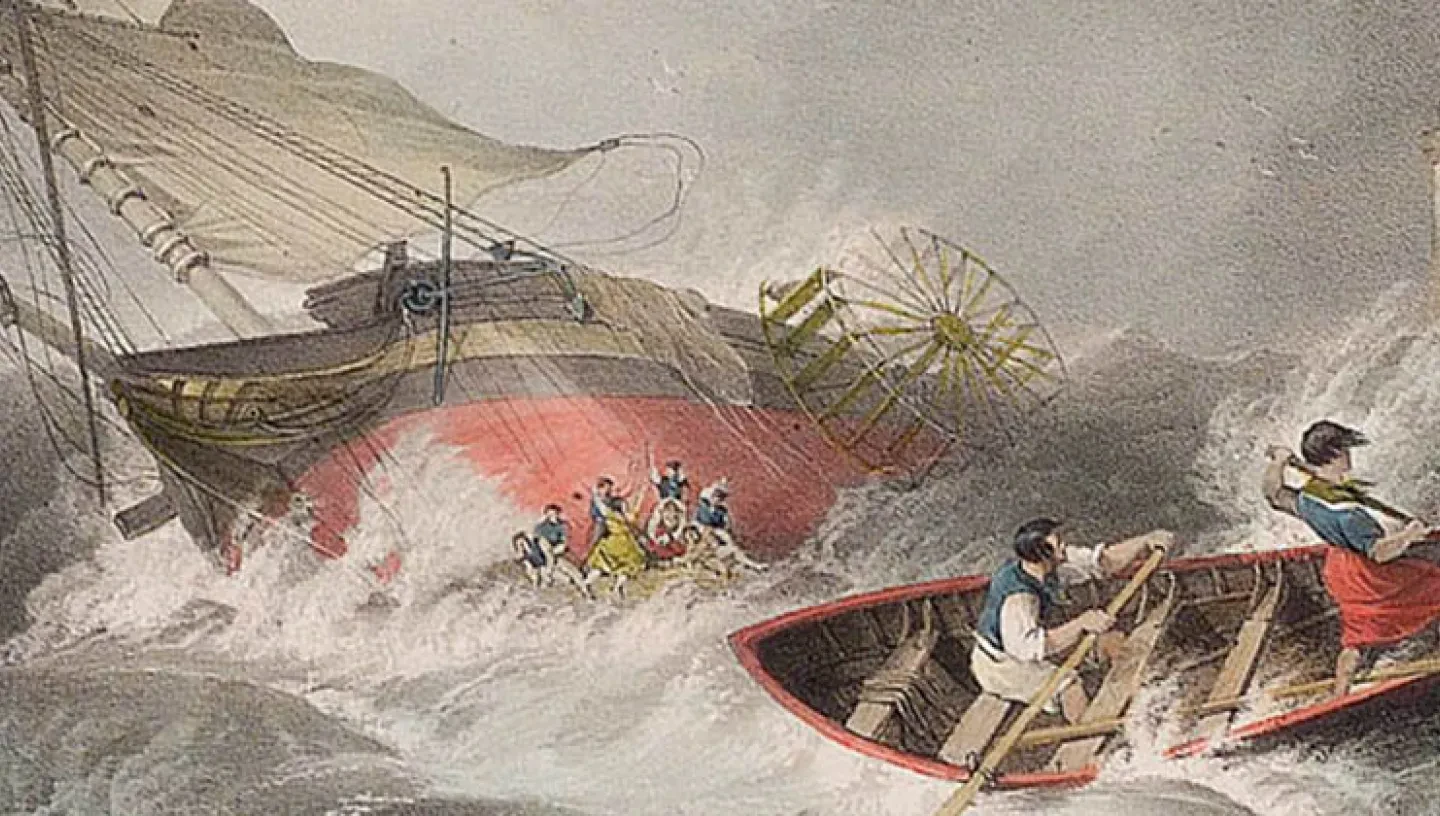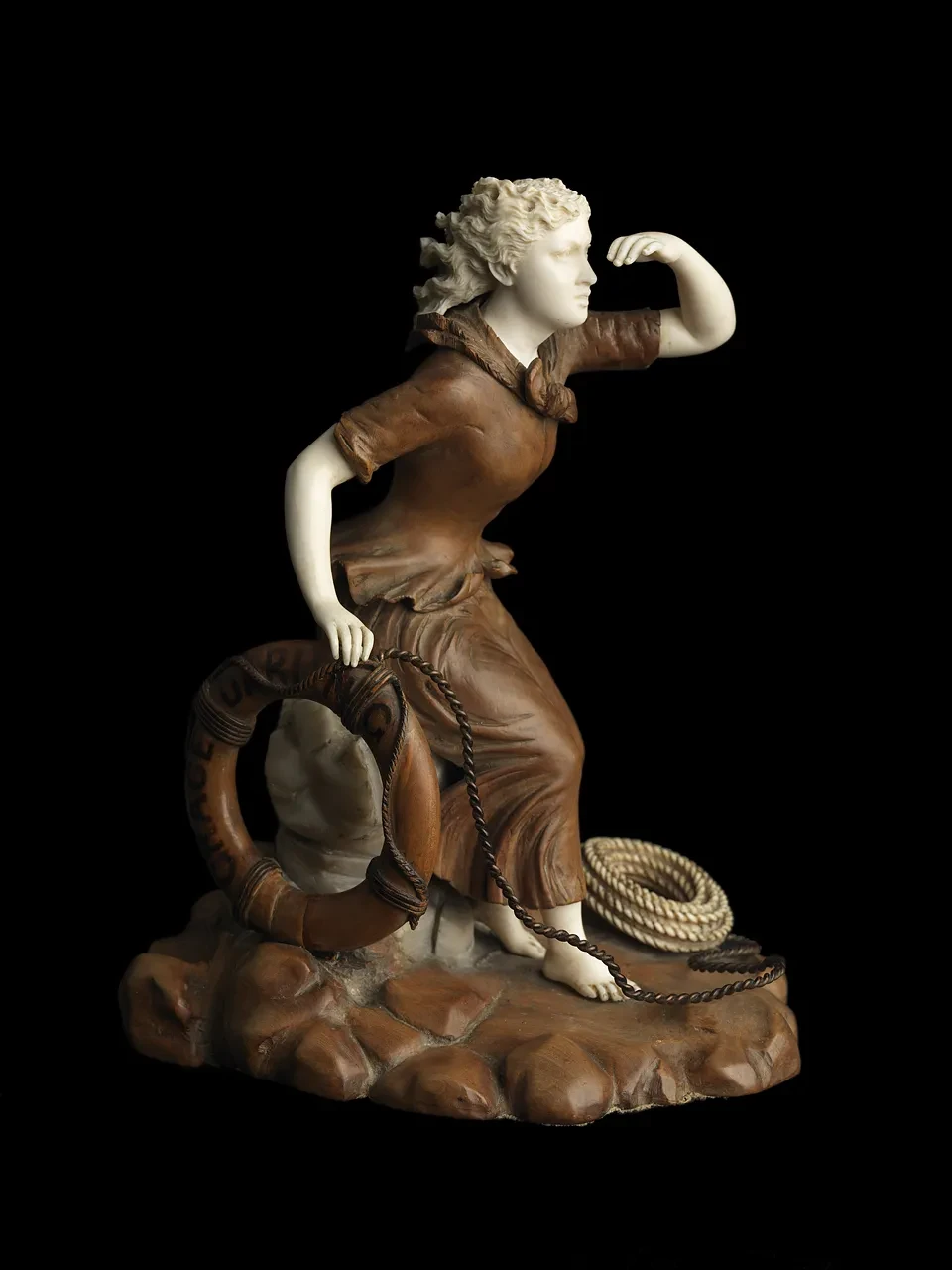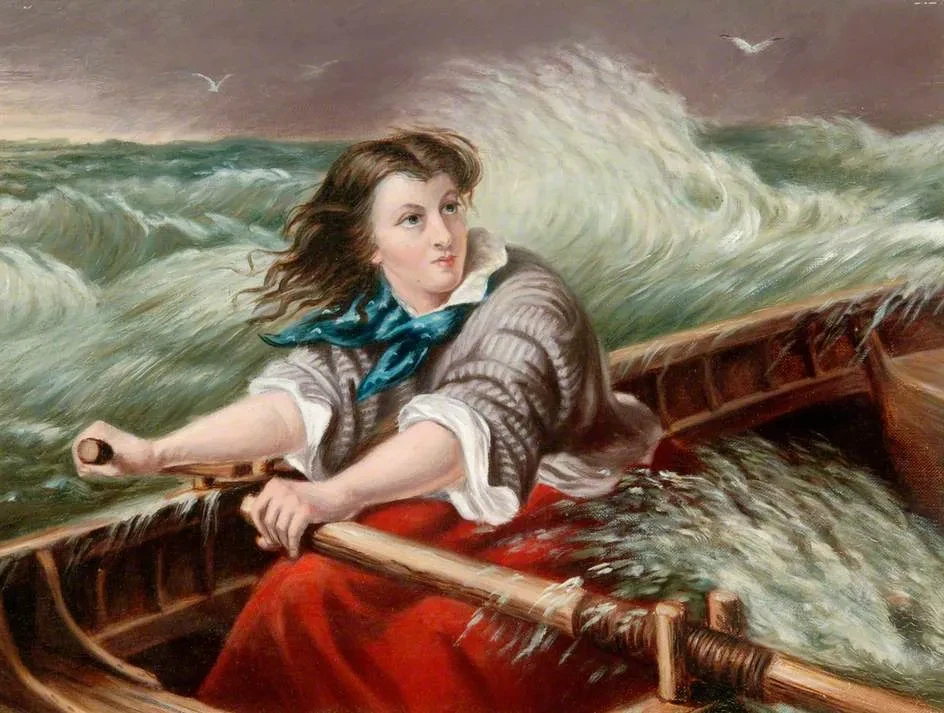
Grace Darling, born 1815, was one of the most celebrated figures of the nineteenth century. She lives on in the collections of RMG and in our broader national memory.
by Ellen Weineck, Curatorial Intern
The daughter of a lighthouse keeper, she is famous for saving nine lives from a shipwreck, in 1838. She carried out the rescue alongside her father William, but it is her name that has been remembered. The Oxford Dictionary of National Biography lists her as ‘Grace Darling, heroine.’ Why has Grace’s deed resonated so strongly? It is largely because she was a woman and Victorian Britain had few female role models. Her actions have been consistently referred to in discussions on gender norms and she has been a figure used to push certain agendas.
Grace lived with her family in the Longstone lighthouse, off the coast of Northumberland. She helped with cleaning, lighting lamps and keeping watch. Shipwrecks were a common occurrence as there were many dangerous rocks around the Farne Isles. Early on the morning of September 7th, 1838, Grace spotted the wreck of the steamship Forfarshire and some survivors out on the rocks. She called her father and together they went out in their coble (a small fishing boat), successfully rescuing all nine. This act of bravery soon caught the attention of the media, which focused almost exclusively on Grace. The Newcastle Chronicle proclaimed, ‘This perilous achievement stands unexampled in the feats of female fortitude’. Grace attained a celebrity status almost unheard of in her age. Locks of her hair were kept as relics and her name was used to sell consumer goods such as soap. There were numerous visitors to the Longstone, all hoping to catch a glimpse of the heroine. She was commemorated in songs, poems and paintings; her name being deemed worthy of immortality. Grace found the constant attention overwhelming and she tried to maintain an ordinary life on the island. Sadly, she died of tuberculosis, at the age of 26. Such an early death meant that her image was preserved and her fame continued.
Such an early death meant that her image was preserved and her fame continued
Grace and William Darling deserve to be applauded for their courage. They viewed the rescue as part of their normal duties. However, it was not without risk, and they would have been aware of this. William noted in his report to Trinity House that the coble would only have been able to return if there were survivors strong enough to help them. There is also evidence that the weather was particularly stormy. On the same morning the Forfarshire was discovered, a fishing vessel nearly capsized.

Heroism and gender
Grace’s actions were viewed as remarkable as they were unusual for her gender. Her brother would have been in her place had he not been away. Showing courage and risk-taking were viewed as particularly masculine traits. It was also considered quite a feat for Grace to steady the coble next to the rock as her father climbed out to get to the survivors. Women were associated with beauty, not strength. Many who met her were surprised by her appearance, expecting her bold actions to be matched by manly features. The Mercantile Gazette reported, ‘She is not the amazon that many would suppose her to be, but as modest and unassuming a young woman as you can imagine’.
Yet at the same time, the rescue was used to promote an ideal femininity. It was interpreted to support the view that women are care-givers. As Florence Nightingale became ‘the lady with the lamp’, in a similar vein Grace Darling was pictured with her coble. The historian Hugh Cunningham argues that these symbolic images helped to reinforce separate gender spheres. While men went to war, and made money, women performed pure and worthy deeds such as saving lives.
Parts of the story were exaggerated, some entirely made up. The first four books about Grace were fictionalized accounts. They romanticised her actions, making them more appealing to a sentimental early Victorian public. For example, Jerrold Vernon’s novel, Grace Darling or the Maid of the Farne Isles (1839), imagined aspects of Grace’s childhood to emphasise her sweet and dutiful nature. Myths developed that Grace had persuaded her father to go out in the coble against his better judgement and that she had heard the cries of the survivors from the lighthouse. Images also played a significant role in shaping perceptions. One of the most famous was by Thomas Brooks, depicting Grace alone in the coble. She has a look of determination on her face, as she strongly grips the oars. The painting was intended to show the moment after William stepped out onto the rock, but it helped create the legend that Grace rowed out alone.

Memory and falsehood
Grace’s family were troubled by the many falsehoods being perpetuated. Her sister Thomasin enlisted the help of Daniel Atkinson to produce Grace Darling; Her True Story (1880). She was concerned that their father had been portrayed as weak-willed, giving in to Grace’s pleas to go out in the coble. Thomasin wanted to maintain the family’s respectability, insisting that William was ‘master in his household’.
Grace’s iconic status was not only due to the rescue itself but also the way she conducted herself afterwards. In Eva Hope’s Grace Darling: The Heroine of the Farne Isles, 1875, she was held up as a shining example of how the ideal woman should behave. Hope was keen to emphasise Grace’s piety and dedication to domestic duties. She states, ‘A woman’s work is that which she sees needs doing’. In this way Grace’s deed was just an extension of her everyday chores at the lighthouse and it is argued that she was quite content with her lot.
In the twentieth century, Victorian accounts of Grace came under heavy criticism. Richard Armstrong’s Grace Darling: Maid and Myth (1965), attacked Eva Hope’s arguments for being far too simplistic. It condemns the subjugation of women in the period. Armstrong suggests that Grace may not have been happy to stay living on the island, but felt pressured into helping her parents. There may have also been a love interest for Grace, which is not mentioned in earlier works. Grace made references to ‘George’ in some of her letters. While we can only speculate about who he was, it is clear that the Victorians felt the most appealing version of Grace was modest and virginal.
It is clear that the Victorians felt the most appealing version of Grace was modest and virginal
Though not as well-known as she once was, Grace’s name lives on. There is a Grace Darling Museum near her birth place in Bamburgh, with the coble on display. In 2004 she was voted Northumberland’s top woman. Her name itself is memorable as a reflection of her qualities. The purity of her motivation also endears her to us. Her example has been used to encourage schoolchildren to think about what they would do in a moral dilemma. Over the years, her name has been caught up in complex and often contradictory debates on gender, but perhaps now we should remember Grace Darling for her simple act of heroism.